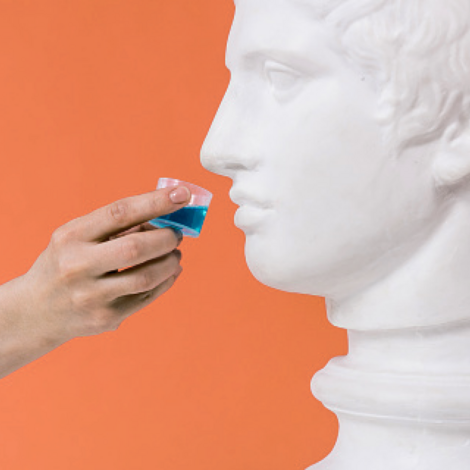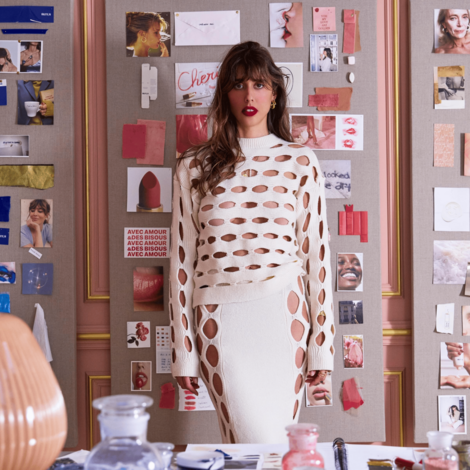I caught up with one impeccably put-together friend a few weeks ago over a leisurely lunch, Italian in length. As we got up to leave, she pulled out a black leather lipstick tube from her purse and twisted it up to reveal a charcoal black bullet that she skimmed over her mouth—no mirror. It left behind an incongruous light pink stain.
This friend wouldn’t dare touch a nail polish darker than Ballet Slippers, hence the lipstick caught my eye. “Whoa,” I said, making grabby hands at her Givenchy Le Rouge Interdit Balm 10. “Isn’t it so cool?” She said with a sheer berry grin. “And it looks different on everyone!”
I am no stranger to the pH-color-changing lipsticks of yore. I’m a product of the Y2K era, when mood rings were taken as seriously as astrology is today, and color-shifting makeup was considered the pinnacle of innovation. Lipstick Queen launched the Frog Prince lipstick in 2006 that was Elphaba green and transformed to various tones of pink in situ. Just three years later, Dior’s Lip Glow arrived—a translucent pale-pink balm that imparted a personalized tint; it’s still a hero product for Dior, expanding to multiple finishes and shades. Since then, pH-reactive lip balms have gone in and out of favor, but those that endure have one thing in common: an inky-black hue in the tube.
This could be the Baader-Meinhof effect at work or perhaps the Rolodex of beauty knowledge in my brain, but I started to recall all of the recent black lipsticks that caught my eye. Isamaya Ffrench’s Vanity lip balm—housed in an unsubtle if memorable case that looked like a phallus—sold out quickly after launching. Pat McGrath’s Fetish Lip Balm in Noir is perpetually out of stock. I still have a tube of Uzu, the Japanese lip treatment in -4 Black that was discontinued in the U.S. It glides on like a lip gloss, leaving behind a shimmery black veil that deepens your natural tone. It’s similar to Isamaya Ffrench’s Liplacq in Black Veil, but hers also plumps and stains. Shu Uemura, not necessarily known for daring color palettes, has a matte black balm. Even the shaving brand Harry’s has a black lip salve for men that also leaves behind a quiet shade of pink. Most recently, I picked up a tube of those TikTok-viral Rom&nd Glasting Melting Balms in a limited-edition shade 17 Berry in Black, which turns a violent hot pink on my mouth.
The qualms people have with these pH-reactive lip colors is that you don’t know what they’ll actually look like when they hit your mouth. Far too many morph into a shocking-pink stain. That’s also the draw—the curiosity of what hue your particular pH will manifest. It’s a bit like gambling or dating; I always approach all three thinking, Maybe this is the one.
The sheer lipsticks that start black and stay that way aren’t necessarily witchy. Their gossamer texture gives them the ability to deepen your lip color in a surprisingly graceful way. But their novelty appeals even to minimalists. For prime millennials like me, color-shifting black lip balms have a nostalgic tug that call me back even though I hate hot pink on me. They remind me of my short-lived baby-goth aspirations and the camaraderie of sharing lipstick with friends just to see how it looked on each of us. That feels entirely unsanitary now, but at the time it was a key bonding activity.
It makes perfect sense why these magical lipsticks appeal to the younger Gens Z and A, who appreciate novelty and individual expression in their beauty experience. A little presto change-o in each swipe keeps things light and interesting, especially when the culture, via TikTok, is busy pushing the extremes of either beef tallow or surgery.
The stakes have climbed, but the humble black lip balm makes its appearance year after year, reincarnated each time to appeal to the maverick in us all who craves a bit of dissonance in a world of aesthetic homogeneity. There’s something comforting in the kind of transformation you can try for a moment and wash off when you change your mind and move on.
Sable Yong is a beauty writer and a co-host of the podcast Smell Ya Later. She writes the Hard Feelings newsletter. Her essay collection, Die Hot with a Vengeance, was published by HarperCollins





